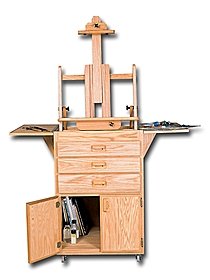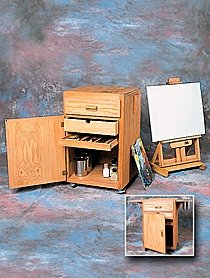So, you’ve finally decided to take the plunge and begin your adventure in the world of art.
You’ve purchased all the necessary paints, supports and brushes.
Now, it’s time to fine tune your studio and set it up with all the things that will make your painting life productive and efficient.
The questions you may be asking are what do you need, what do you want, and which products out there are primarily produced with the sole purpose of adding to the manufacturer’s coffers?
As you develop your style and become acclimated to your space, you’ll find out a lot about what’s important to you. As you expand your experience, your needs may shift or change entirely.
Since every artist has different expectations, available space and budgets, the essentials may not be the same as other artists. However, there are some basic things that almost every artist should have.
Light Up Your Space
Lighting is crucial for any artist. If you’re blessed with natural northern light, you should thank your muse. If you have any decent windows, give her a high-five. If you’ve nothing but an ill-positioned basement window that looks out onto a window-well, never fear. Modern technology will be your friend and you can have clean, natural lighting with a flip of the switch and regular payments to your electric company.
Northern light is the best of all lighting. You don’t have the direct glare of the sun, and the illumination remains quite consistent for a good portion of the day. An eastern window has the glare of the sun in the morning and a western window has a long bout of afternoon glare. Southern windows have that annoying glare for a good portion of the day. With all three exposures, there are the changing patterns of shadows with which to contend.
A suitable alternative for natural lighting is a full spectrum light bulb. Full spectrum lighting is important for you to have a true sense of your color choices. Incandescent lighting has a yellow cast, and fluorescent lights are a very stark blue-white. Both of these lights affect how you see your colors, and this can have a real impact on the appearance of your final work.
Purchase some good, full spectrum lights to illuminate your studio. They come in all sizes, shapes and prices, so you can choose the style and price that fits your needs and budget. You’ll need a light to paint by and a light or two for setting up still life compositions. There are many styles of table lamps, clip-on lamps and floor lamps available.
Work Surfaces – Large And Small
You have any number of choices of work surfaces. You may use an easel, a desk, a drafting table or sit cross-legged on the floor and hold a pad between your knees. In fact, if you work with different media, techniques or sizes, you may want several work surfaces from which to choose.
If you’re painting with oils or acrylics, you’ll find that most artists prefer to paint at an easel. This is especially true if you’re working on jumbo-sized canvases. Standing at an easel promotes full body painting. Your whole body moves and influences the way you paint.
However, if you work small, do water colors or other fine work, you may find that it’s more suitable to sit at a desk or drafting table. If you’re lucky enough to have ample space, consider furnishing your studio with both a flat workspace and an easel.
Storage For All Your Supplies
You’ll need to store Paints, Paper, Canvas and Tools somewhere. This list should help…
Supports
Just like any other room in the house, there never seems to be enough storage for all your paraphernalia. You need a space for your stock of supports, completed pieces and drawing pads. This inventory would appreciate remaining flat, and there are large drawer systems that are large enough to hold full sheets of watercolor paper. However, these drawers are costly and do take up a fair amount of space.
Fortunately, there’s a wealth of underused space beneath most beds. You can store a lot of canvases or sheets of watercolor paper under your bed. You could also consider storing these items above the rafters in the attic or garage, if those rooms are dry and pest-free.
You can also stack up canvases or boards at the back of a closet. Alternatively, you can use smaller supports that will fit neatly into storage tubs.
Painting Supplies
If you’re frugal or a minimalist, you don’t need a very large space to store tubes of paint, brushes and a palette or two. However, most artists tend to be pack rats, and we acquire all sorts of detritus. We find intriguing paints, great deals on brushes and all manner of things that we know will be great to have for a painting one day.
A tabouret is a great piece of furniture for an artist. This piece of furniture is a cart with wheels and a number of shallow drawers. A moveable storage center can hold all your supplies, and the top acts as a table to hold your current palette, brushes, and other painting necessities. It also can be pushed to the corner or stored in a closet when it’s not in use.
 |
 |
A great tabouret is a rolling tool chest. These sturdy chests have loads of shallow drawers and wheels so they move easily around your studio. If a new one is out of your price range, check garage sales and estate sales for a used piece.
Miscellaneous Storage
You’ll be far more productive if you keep clutter to a minimum. Bookcases, cabinets and shelving that provides ample storage for your growing collection of art materials and inspirational bits and pieces is important for your physical and psychic well being.
If you’re not constantly irritated by a messy workplace, you’ll be far more creative and efficient. You’ll also save time by not needing to tear the place apart looking for missing supplies.
If you have space to keep all your supplies in one place, you’ll be able to keep better track of what you have. This minimizes buying multiples of expensive paints and supports because you forgot that you already had them in stock. Another bonus of having everything visible is that you’ll be more likely to incorporate interesting things in your artwork that you may forget about if they’re hidden away in the basement or attic.
These essentials are not very glamorous or romantic. In fact, the list is rather utilitarian. However, keep in mind that these art studio features are fundamental basics. You can always add luxury supplies and studio elements as your budget allows, but these essentials are important for you to progress as an painter and make the most of your artistic experience with minimal costs.